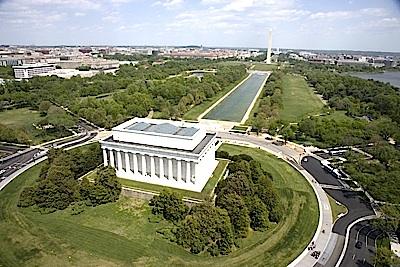The nation's front yard -- the National Mall in Washington, D.C. -- is hammered pretty hard each year by more than 25 million visitors. To reduce their impact on the grassy expanse, Interior Secretary Ken Salazar has directed the National Park Service to better manage the promenade that stretches from the Lincoln Memorial to the U.S. Capitol.
That's no small task.
The Mall sprawls across more than 1,000 acres, had its beginnings when George Washington was president, and today contains more than 80 historic structures and more than 150 major named historic parks, squares, circles and triangles. Here you'll find the Lincoln Memorial, the Washington Monument, the Vietnam Memorial, the World War II Memorial, the Smithsonian Castle, the Japanese cherry trees that cast their pink petals into the Tidal Basin each spring, more than 170 flower beds, and 35 ornamental pools and fountains.
“We have made major investments in the National Mall over the past few years so that ‘America’s Front Lawn’ is fit to welcome visitors from around the world to our nation’s capital and to host historic events such as presidential inaugurations,” Secretary Salazar said when issuing a "Secretarial Order" guiding the Mall's long-term upkeep. “This order supports the National Park Service’s work to protect this national treasure and to keep it healthy and beautiful for all to enjoy.”
The announcement last week complements the larger National Mall Plan that was implemented in 2010 after a thorough public comment process. As part of the multi-phase plan to revitalize the Mall, the National Park Service has completed a number of projects, including the restoration of the Lincoln Reflecting Pool, repair of the Tidal Basin seawall at the Thomas Jefferson Memorial, and restoration of the DC War Memorial.
Most recently, the Park Service completed a major rehabilitation of the Mall between 3rd and 7th Street. This innovative project includes a new drainage and irrigation system, underground cisterns to capture and allow reuse of rainwater and an engineered soil system to help resist compaction. The agency will soon replace turf on the Mall between 7th and 14th.
The National Park Service is taking a number of steps to protect the sod, including temporarily fencing off areas and laying down protective flooring for major events. The Secretarial Order will help reduce further wear and tear on the Mall as visitation grows from 25 million annually to an expected 42 million in next 20 years.
“The National Mall presents a special challenge for the National Park Service,” said Park Service Director Jonathan B. Jarvis. “We want millions of people to freely enjoy the National Mall and to gather together there to exercise their First Amendment rights. And we want this historic landscape to be an enduring and attractive place worthy of a premier national park that celebrates our national heritage and ideals. This Secretarial Order will enable us to balance those two objectives through state-of-the-art turf management and other actions.”
At the Trust for the National Mall, a non-profit organization that works with the Park Service to care for the mall, President Caroline Cunningham applauded Secretary Salazar's order.
“These steps are a smart investment in a more sustainable, usable and beautiful Mall," said Ms. Cunningham.
The Secretarial Order directs the National Park Service to implement a multi-faceted preservation strategy that manages and sustains the high levels of diverse use by taking actions, including:
• Increasing non-turf areas to better accommodate the use of temporary structures for appropriate permitted activities and increase the desirability of those areas by providing access to electricity, water, and communications.
• Developing professional staff to identify and implement best practices for turf management and to develop public use permits that take those turf management concerns into consideration.
• Structuring special events to protect resources, reduce impacts, and working with event organizers to identify suitable locations for events which will facilitate their activities and protect the cultural and historic resources of the park.
• Ensuring the Mall is restored to its original condition following events, including requiring organizers to provide proof of sufficient funds to rehabilitate or replace damaged turf and resources.




Add comment